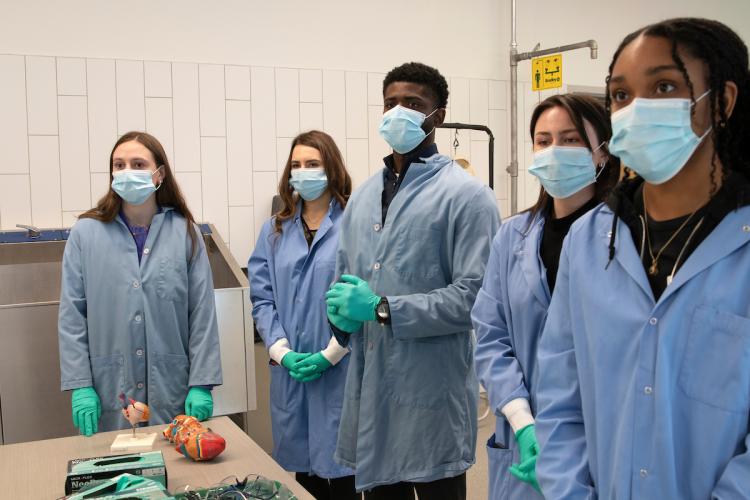
Undergrads find passion for medicine at Medical Student for a Day

For undergraduate Juliana Sanchez-Radovanovic, visiting the Ohio University Heritage College of Osteopathic Medicine was eye-opening and not only because she learned how to give someone an injection or saw the intricacies of the human body in the anatomy lab. The aspiring medical student learned for the first time about osteopathic medicine and how it is different from allopathic medicine.
“It made me realize that the D.O. path seemed a better fit for me rather than the M.D. track,” said Sanchez-Radovanovic, a sophomore at The Ohio State University.
Sanchez-Radovanovic was one of nearly 70 underrepresented minority students from universities across Ohio who recently spent a day at the Heritage College to learn what it is like to be a medical student. The chapter presidents of the Student National Medical Association at each of the college’s campuses coordinated Medical Student for a Day with the help of numerous volunteers to not only help familiarize undergraduates with the day-to-day activities of medical school but to show underrepresented minority students (URM) that attending medical school is attainable.
“URM students tend to lack prior exposure to these experiences, so programs like MS4D [Medical Student for a Day] strive to bridge that gap. Early exposure to medicine not only helps direct students toward successful matriculation into medical school but also develops an interest in those who may not have previously considered the medical field,” said SNMA Athens Chapter President Obarikanemi Nwogu, OMS II.
That was the case with SNMA Cleveland Chapter President Imani Sellers, OMS II. She attended Medical Student for a Day several times as an undergraduate and said it’s why she’s now a medical student.
“The medical field can be very discouraging when the majority isn’t a reflection of who you are, so programs like this are very helpful in encouraging students to keep going,” said Sellers.
While the number of underrepresented minority physicians in the United States has been increasing, it is doing so at a slower rate than the population, which, according to a report in JAMA, will result in increased underrepresentation. A recent study found that URM family physicians are more likely to care for patients from vulnerable populations than non-URM physicians, yet less than 11 percent of active physicians identify as underrepresented minorities. The concern is that if the gap in URM physicians continues to widen, so will disparities in health outcomes. For many medical students, including Arkan Katabay, OMS II, SNMA chapter president on the Dublin campus, it’s these and other health care inequities that propelled them to pursue medicine.
“The only way to address this issue is to fill medical spaces with doctors who are aware of the inequities embedded in our health care systems and are determined to dismantle those inequities,” he said.
Although Nwogu likes how medicine combines science and interpersonal relationships, and as an athlete she appreciates the human body, she said her desire to become a physician was further sparked when she worked in health care in an underserved community.
“I witnessed the importance of addressing social determinants of health as they often drive health disparities, leading to worse patient outcomes for disadvantaged individuals,” she said. “By joining this field, I know I can help bring light to the roots of these social determinants so they can be combatted.”
At Medical Student for a Day, participants learned about the admissions process, went on a campus tour, and engaged in hands-on exercises in anatomy, clinical skills and osteopathic manipulative medicine labs.
“Especially if you have little to no knowledge on the D.O. track, this is an amazing experience to familiarize yourself with the path. It is a path in medicine that is not discussed widely compared to the M.D. route. Truly amazing experience,” Juliana Sanchez-Radovanovic said.
“A few were shocked at how hands-on the day would be with all of the activities we had planned. Towards the end, they all seemed very committed to becoming a physician. I believe the program helped to solidify their passion for medicine,” said Sellers. “It is a reminder for the students that they can do it, too. What keeps me coming back is the excitement and joy I see on their faces during the program. It is very rewarding to see them take full advantage of these opportunities and to know myself and my colleagues were a part of their inspiration to seek greatness.”
Being a catalyst for change is one of the reasons Nwogu has been involved with the Medical Student for a Day program.
“One of our goals is to expand the pool of medical school applicants and help promote a culturally competent, diverse and prepared healthcare workforce that will enhance patient care and ensure health equity. By the end of the day, several students on the fence about applying to medical school shared that their desire was reignited, thus supporting this mission and verifying the importance of this program,” said Nwogu.
For Sanchez- Radovanovic who had never attended an event like this before, she said it exceeded her expectations.
“Especially if you have little to no knowledge on the D.O. track, this is an amazing experience to familiarize yourself with the path. It is a path in medicine that is not discussed widely compared to the M.D. route. Truly amazing experience,” she said.
Katabay said the most important takeaway from Medical Student for a Day is that undergraduate students can walk away believing that this is a career path they can follow.
“I wished as a younger student, I attended events like this and was able to see someone that looks like me, achieve that dream that they aspired to reach since a young age. MS4D is a way I can potentially make that type of impact on the next generation of future physicians,” he said.
